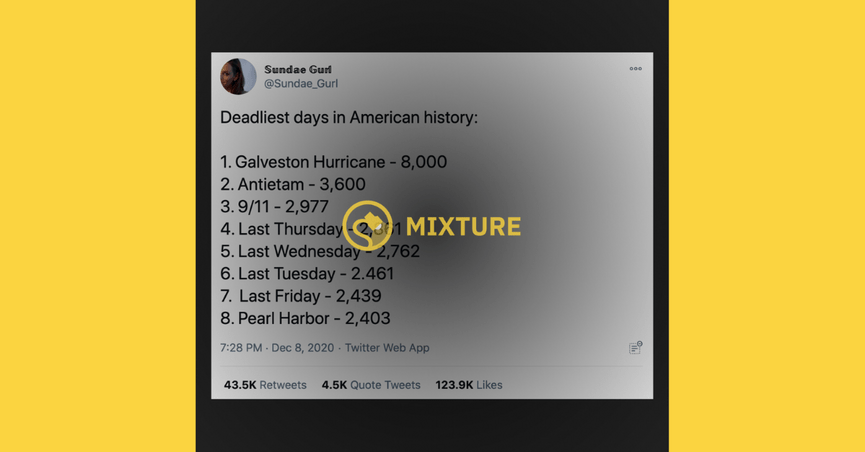一个广泛分享的模因将 COVID-19 造成的死亡置于严酷的历史背景下。
【宣称】
由于 COVID-19 疫情,“美国历史上最致命的八天” 中的四天发生在 2020 年 12 月的第一周。
【结论】
混合

【原文】
In December 2020, amid a renewed surge in new COVID-19 cases and deaths in the United States, many thousands of internet users shared a list that purported to put the devastating impact of fatalities from the pandemic into stark historical context.
On Dec. 8, Twitter user @Sundae_Gurl posted a list of the eight “Deadliest Days in American History,” with four of the eight purportedly taking place during the first week of December 2020 (image above).
Memes that included the same content and figures were widely promoted on Facebook, Twitter and Instagram.
The list shared widely in December 2020 contained some notable omissions and questionable figures, and the inclusion of likely daily death totals from the peak of the 1918 influenza pandemic would eclipse those resulting from COVID-19 between Dec. 1 and Dec. 4, 2020, and see them relegated from the “Top 8”.
Nonetheless, the daily death tolls from COVID-19 have indeed been very high by historical standards. It is of particular symbolic significance that several days in 2020, including during the first week of December, saw more deaths from COVID-19 than the 2,403 American deaths that resulted from the attacks on Pearl Harbor on Dec. 7, 1941 — a milestone event in modern American history, which President Franklin D. Roosevelt dubbed “a date which will live in infamy.”
Notable mass-fatality events omitted from the list include the San Ciriaco hurricane, which killed a reported 3,369 people in Puerto Rico, after it made landfall there on Aug. 8, 1899; and the Lake Okeechobee hurricane, which killed an estimated 2,500-3,000 people as it swept through parts of Florida on Sept. 16, 1928.
Historically, the death toll from the San Francisco earthquake on April 18, 1906, had been set in the hundreds, but decades of research led by former city archivist Gladys Hansen revealed more than 3,400 deaths directly attributable to the disaster, as well as a political cover-up of those fatalities. In 2005, the San Francisco Board of Supervisors formally voted to record a new official death count in accordance with Hansen’s research.
Finally, the 1918 flu pandemic caused hundreds of thousands of fatalities throughout the United States. Daily death totals are not available, but the U.S. Census Bureau recorded all deaths from influenza and pneumonia as attributable to “pandemic mortality” and reported (page 27) that 477,467 such deaths had taken place in the U.S. in 1918. Of those, 79.8 % took place in “the last four months of the year” — Sept. 1 through Dec. 31, 1918.
That’s 381,019 deaths from the flu pandemic in just 122 days, an average of 3,123 per day. Given that that figure is only an average, it is certain that at least a few days during the autumn of 1918 saw death tolls from the flu pandemic comfortably in excess of 3,000, which would cause the four days from early December 2020 to be further relegated in the rankings of “The Deadliest Days in American History.”